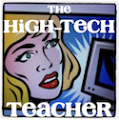So the first big event of the school year is Open House. Parents come because they want to meet their child's teacher and see where their kids will be located for the year. You tell them a little bit about yourself, what your plans for the school year are, what they can expect their child to learn, you might even talk a little bit about testing (just a little). They might pick up a classroom supply list, ask you what you think is your most essential school tool...But for the most part it's a "Hello-how-are-you?-Who-are you?" meeting.
To spice things up this year, I think I want to throw a theme party for Open House, and the kids can help. I want it to be just like a kid's birthday party with maybe even "Pin-the-Tail on the Donkey" (do they still play that?).
This year, Open House for me is the second day of school. You can see, there's not a lot of time to get the kids involved throwing up their beginning-of-the-year work to display. So I'm going to have them help me throw up decorations, maybe make some "ants on a log." (Our theme is "forest" btw. I haven't decided if it's enchanted or not yet. I think maybe just whimsical.) It'll be just like a kid's birthday party with snacks, drinks, maybe some kids' DIY prizes. IDK. (Oooh, I should bake a cake...or maybe order one.)
But, as I have no kids in the home, I've never really thrown a "kid party" before. I've been to them, just not thrown them; and I know the two roles are WAY different. So, I'm going to ask my AMAZING FOLLOWERS, any advice anyone has to offer is greatly appreciated. I think throwing a party and having the kids help would make for a great team building activity (which I'm a huge fan of. We even call the class "Team Jayne's Class" instead of "Mrs. Jayne's class." It helps reinforce the team idea. The latter makes it sound like the class belongs to me...You can steal that idea if you want.)
Anyway, this party idea is going to take a lot of planning on my part , especially since the kids will all be helping "last minute." (And I have ZERO experience, which will make it all the more fun right?) I'll go Pinterest-surfing for ideas but, again, any ideas from you are greatly appreciated and thanks a million!
Hope your summer is going well!















